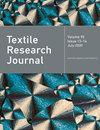花式纬编织物的纱线级建模和仿真
IF 1.9
4区 工程技术
Q2 MATERIALS SCIENCE, TEXTILES
引用次数: 0
摘要
纬编织物是由相互交错的线圈形成的,因此结构不稳定且容易变形。特别是花式纬编织物结构变化多样,分布不均,导致不稳定和变形的特点更为突出。要达到理想的图案效果和尺寸,往往需要绘制多个设计图。在这项工作中,为了获得花式织物的几何模型,根据四种针法的基本结构,即平针、掖针、浮针和移圈针,建立了带有运动矢量的网状环模型。立方体 Catmull-Rom 样条曲线用于拟合纱线的几何中心线。运动矢量用于表示花式织物中标准线圈关键点位置的变化,这些关键点是通过对图案网格的分析得出的。根据纱线的受力分析建立物理模型,通过求解欧拉-拉格朗日动态方程确定纱线控制点的位置。通过迭代计算,可获得织物的变形效应,从而实现花式纬编织物的仿真。提出的算法使用 Visual C++ 实现。通过比较模拟结果与实际样品的轮廓,证明了模拟方法的可靠性和准确性。本文章由计算机程序翻译,如有差异,请以英文原文为准。
Yarn-level modeling and simulation of fancy weft-knitted fabric
Weft-knitted fabric is formed by interlocking loops, which results in an unstable and easily deformable structure. In particular, fancy weft-knitted fabric exhibits diverse structural variations and uneven distribution, leading to more prominent characteristics of instability and deformation. Achieving the desired pattern effect and dimensions often requires drawing multiple designs. In this work, to obtain the geometric model of fancy fabric, mesh-loop models with movement vectors are established based on the basic structure of four stitch types: plain stitch, tuck, float, and loop transfer. The cubic Catmull–Rom spline curves are used to fit the geometric centerline of the yarn. The movement vectors are used to represent the changes in the position of the key points of the standard loops in the fancy fabric, which are derived from the analysis of the pattern grid. A physical model is established based on the force analysis of the yarn, and the positions of yarn control points are determined by solving the Euler–Lagrange dynamic equations. Through iterative calculations, the deformation effects of the fabric are obtained, enabling the simulation of fancy weft-knitted fabric. The proposed algorithms were implemented using Visual C++. The reliability and accuracy of the simulation method are demonstrated by comparing the contours of the simulation results with the actual samples.
求助全文
通过发布文献求助,成功后即可免费获取论文全文。
去求助
来源期刊

Textile Research Journal
工程技术-材料科学:纺织
CiteScore
4.00
自引率
21.70%
发文量
309
审稿时长
1.5 months
期刊介绍:
The Textile Research Journal is the leading peer reviewed Journal for textile research. It is devoted to the dissemination of fundamental, theoretical and applied scientific knowledge in materials, chemistry, manufacture and system sciences related to fibers, fibrous assemblies and textiles. The Journal serves authors and subscribers worldwide, and it is selective in accepting contributions on the basis of merit, novelty and originality.
 求助内容:
求助内容: 应助结果提醒方式:
应助结果提醒方式:


